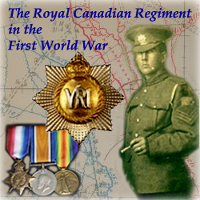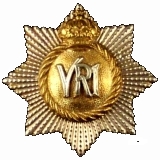
The First World War
An RCR Officer's Diary 1914-1918
APRIL 1917
By 4.20 a.m. on the morning of April 9th everything was ready and everyone in position for the attack on Vimy Ridge. The enemy had been very quiet during the night, but when our our barrage opened at 5.30 a.m. they immediately replied by bringing down theirs on our line. Fortunately they were either surprised as to the date or hour of our attack or were unaware of our jumping off points as their barrage fell harmlessly in rear of our line it was very weak.
The platoon was divided into four sections and a platoon headquarters, a bombing section, Lewis Gun section, rifle and bayonet section and a rifle grenade section. In this manner practically any situation could be handled effectively on the spot and the success at Vimy certainly justified this contention.
At 6 a.m. the regiment went over and so quickly did they move that they even surprised the sentry (commonly known as Flarelight Bill) whose duty it was to send up the S.O.S. Rocket, he was bayoneted in the act of sending it up.
At the time of the attack it was raining slightly with a cold north west wind which formed a slight mist. This assisted us greatly in surprising the enemy. Later in the day it snowed and rained heavily.
The task allotted to the regiment was the capture of two objectives, the first a line of trenches about 800 yards forward, the second the Ecole Commune, the chateau and western edge of La Folie Wood some 400 yards further on. The frontage was approximately 250 yards with 4th Cdn Mtd Rifles on the right and P.P.C.L.I. on the left. Assisting were four guns of 7th Cdn M.G. Co., two guns 7th Cdn Trench Mortar Battery (Stokes guns), a party of 7th Field Co. Cdn Engineers with the Brigade wiring party, and two platoons of 49th Cdn Battn (Edmonton Regt) which acted as "moppers up".
No man's land averaged averaged about 90 yards across at the point allotted to the regiment. The jumping off trenches had been dug about half-way across among the craters which were very numerous in this sector, behind this about 30 yards a new trench was dug.
"C" and "D" Cos., having been alloted the first objective, assembled in the jumping off trench, "C" Co. on the right and "D" Co. on the left.
"B" and "A" Cos. were given the second objective and assembled for the attack in the new trench.
"C" and "D" Cos. went over in "waves" at 20 paces distance and 2 paces interval. The "mopping up" platoon from 49th Bn followed the first wave.
The third platoon of each company acted as a carrying party.
"C" and "D" Cos., having captured their objective, "B" and "A" Cos., which had been following in artillery formation at 50 paces, formed up and passed through them.
They captured the second objective with ease but ran into a strong point on their right in La Folie Wood, this together with some hostile snipers caused considerable trouble. Later they repulsed a hostile counter-attack but a platoon of 49th Bn had to come up to reinforce them in order to maintain touch with 4th Cdn Mtd Rifles on the right.
The work of our Artillery had been terrible, the trenches had practically ceased to exist and the ground was badly cut up.
The Regiment captured three officers (a battalion commander with his adjutant and quartermaster) and about 100 rank and file together with five machine guns and a quantity of other war material.
A tremendous number of the enemy were buried in the large dugouts by the entrances being "crumped in" and obliterated.
The Battalion commander who was captured reported that our Artillery fire had been so terrific that he had been unable to get outside his dugout for eight days and that for the last two days nu rations could be brought up.
The regiment opposed to us was the 2nd Bn of 262nd Reserve Infty Regt. It was completely wiped out for those who had not been killed or buried by the bombardment were killed or captured in our attack.
When "B" and "A" Cos. reached the Ecole there were only two of the enemy left. They behaved most bravely firing their machine gun, which had caused many casualties, right up to the last moment when their gun jammed and they were swamped by our men.
The battalion wore battle order, i.e., web equipment with haversack on the back. Leather jerkins were worn with a waterproof sheet carried in the haversack.
Riflemen were issued 170 rounds of ammunition, two mills bombs, wire cutters and wiring gloves. Some in addition carried a patent wire cutting attachment on the rifle.
Rifle grenadiers carried twenty Mills rifle grenades and four smoke bombs.
Bombers carried 20 Mills bombs and two smoke bombs.
The leading waves of the first two companies carried only the above equipment. Other platoons carried in addition a pick or shovel, barbed wire or screw stakes.
350 shovels, 50 picks, 20 rolls of barbed wire and 35 screw stakes were taken over altogether.
In addition also every man carried one ground flare for use in aeroplane contact work, a Very light and a few some S.O.S. rockets.
It can therefore readily been seen that the attack successfully accomplished over shell torn ground with such loads of supplies and in such weather was no mean task.
A hot meal was given to every man at the last possible moment and a ration of rum issued within half an hour of the attack. Each man carried a full water bottle and two days iron rations.
This was the first occasion on which the new platoon formation was used. It had been found that the platoon must be a self-contained unit with each branch of the infantry represented, This was deemed essential for trench to trench attack.
The platoon was divided into four sections and a platoon headquarters, a bombing section, Lewis Gun section, rifle and bayonet section and a rifle grenade section. In this manner practically any situation could be handled effectively on the spot and the success at Vimy certainly justified this contention.
This system originated from the French and was adopted by all.
The battalion went into action [with] 16 company officers and 632 other ranks. Thirteen officers and 290 other ranks became casualties.
On 11th [Apr] the battalion was relieved by 58th Cdn Battn and returned to Villers Camp.
The following day Maj Gen Lipsett Cmdg 3rd Cdn Div came over to thank the men for their splendid work. In the afternoon Lieuts Bole, Beck, Churchill and Thompson, who had been killed, were buried at Ecoivres Cemetery.
While at Villers the battalion worked on roads necessitated by our advance.
On 13th [Apr] moved to bivouacs consisting of waterproof sheets over vacated trenches relieving the 4th Cdn Mtd Rifles.
On 19th [Apr] Capt Munn, who had died of wounds, was buried at Barlin.
On 24th [Apr] the Brigade being in Corps Reserve, the battalion relieved 1st Cdn Mtd Rifles in the fourth and fifth lines of resistance (just organised in case of hostile counter attack) in the vicinity of Spanden Haus, Zwischen, Stellung and Artillerie Weg, old German trenches. While here the battalion supplied about 400 men a day on working parties.
A draft of 98 other ranks arrived on 28th [Apr] and on 30th [Apr] Lieut Rooks who had died of wounds was buried at Ecoivres Cemetery.
A vast amount of salvage work was accomplished at this time, all ranks were trained in the habit of picking up and "dumping" any battle litter they came across. Rations dropped at night, ammunition, engineering materiel, arms and equipment of casualties, our own and of the enemy all became a great work.
In a few days the battalion collected 170 sets of equipment and 150 rifles in good condition besides numerous bombs, hundreds of rounds of ammunition, Lewis Gun pans, etc., etc.
On 30th [Apr] another draft of 12 other ranks arrived. The battalion having been relieved by 58th Cdn Bn, returned to the "Quarries" Line.
- The O'Leary Collection; Medals of The Royal Canadian Regiment.
- Researching Canadian Soldiers of the First World War
- Researching The Royal Canadian Regiment
- The RCR in the First World War
- Badges of The RCR
- The Senior Subaltern
- The Minute Book (blog)
- Rogue Papers
- Tactical Primers
- The Regimental Library
- Battle Honours
- Perpetuation of the CEF
- A Miscellany
- Quotes
- The Frontenac Times
- Site Map

![]() The RCR in the Great War
The RCR in the Great War
![]() War Diary
War Diary
![]() Battle Honours
Battle Honours
![]() Battle Bars and The RCR
Battle Bars and The RCR
![]() The RCR Battle Bar Ledger (pdf)
The RCR Battle Bar Ledger (pdf)
![]() Honours and Awards
Honours and Awards
![]() Roll of Honour
Roll of Honour
![]() Prisoners of War
Prisoners of War
![]() Cemetery List
Cemetery List
![]() Cemetery Map
Cemetery Map
![]() Courts Martial
Courts Martial
![]() Officers
Officers
![]() RSMs of The RCR (1914-1919)
RSMs of The RCR (1914-1919)
![]() NCOs and Soldiers
NCOs and Soldiers
![]() An Officer's Diary (1914-1918)
An Officer's Diary (1914-1918)
![]() Recollections of a Nonagenerian (R. England) (1916-1919)
Recollections of a Nonagenerian (R. England) (1916-1919)
![]() On to Bermuda (1914-15)
On to Bermuda (1914-15)
![]() England and France 1915-1916 (Hayes; 1931)
England and France 1915-1916 (Hayes; 1931)
![]() Overseas with The Royals (1915)
Overseas with The Royals (1915)
![]() Regimental History Pamphlet (1917)
Regimental History Pamphlet (1917)
![]() Amiens (1918)
Amiens (1918)
![]() Cambrai (1918)
Cambrai (1918)
![]() Monchy-le-Preux (1918)
Monchy-le-Preux (1918)
![]() Under-aged Soldiers in The RCR
Under-aged Soldiers in The RCR
![]() Not All Were Volunteers; The RCR and the Military Service Act
Not All Were Volunteers; The RCR and the Military Service Act
![]() Sentenced to Death by Court Martial
Sentenced to Death by Court Martial
![]() The 7th Trench Mortar Battery
The 7th Trench Mortar Battery
![]() A Regimental Goat
A Regimental Goat
![]() Regiment and Family, Bermuda 1914-15
Regiment and Family, Bermuda 1914-15
![]() "March the Guilty Bastard In"
"March the Guilty Bastard In"
![]() Surrendered as Stowaway
Surrendered as Stowaway
![]() Re-Visiting the Great War Roll of Honour for The RCR
Re-Visiting the Great War Roll of Honour for The RCR
![]() Canadian Corps Trench Standing Orders (1916)
Canadian Corps Trench Standing Orders (1916)

